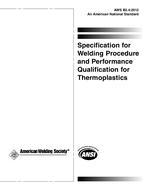No products
 View larger
View larger
AWS B2.4:2012
M00001580
New product
AWS B2.4:2012 Standard Welding Procedure Specification for Welding Procedure and Performance Qualification for Thermoplastics
standard by American Welding Society, 04/10/2012
Full Description
Defines qualification requirements for welding of thermoplastics. Includes requirements for qualification of Welding Procedure Specifications, welders, and welding operators for manual, semi-automatic, mechanized, and automatic welding.Covers electrofusion, hot gas, socket fusion, butt contact fusion, infrared, extrusion welding, and flow fusion welding processes, as well as base materials, filler materials, qualification variables, and testing requirements.
In stock
More info
AWS B2.4:2012
Table of Contents
Page No.
Personnel v
Foreword vii
List of Tables x
List of Figures x
Scope and General Provisions 1
Scope 1
Responsibilities 1
Effective Date 1
Safety 2
Normative References 2
Terms and Definitions 3
Procedure Qualification 6
General 6
Welding Procedures Qualified by Employers 6
Evaluation of Test Weldment/Coupons 7
Qualification Thickness Limitations 7
Special Test Weldment/Coupon Acceptance Criteria 9
Test Weldment/Coupons and Test Evaluation 9
Welding Procedure Specification Data 23
Procedure Qualification Variables 25
Performance Qualification 26
General 26
Qualification by Standard Test 28
Test Weldment/Coupons 28
Examination Procedures and Acceptance Criteria 29
Performance Qualification Variables 30
Examination Structure 31
Examination Basis Documents 31
Examination Structure 31
Annex A (Informative)—Recommended Hot Gas Welding Conditions 33
Annex B (Informative)—Sample PQTR and WPS 35
Annex C (Informative)—Guidelines for Preparation of Technical Inquiries 43
AWS B2.4:2012
List of Tables
Table Page No.
Test Methods Required for Procedure Qualification 7
Thickness Limitations for Procedure Qualification 7
Minimum Short Term Weld Factors 8
Dimensions of Test Arrangement and Test Specimens 8
Ram Displacement Corresponding to Bend Angle of 160° in “No Failure” for Calculation of
the Mean Value 8
Cross-Head Speeds for Some Thermoplastics 12
Symbols and Designations 22
Testing Requirements for Performance Qualification 28
Pipe Group Qualification 28
Base Material for Performance Qualification 29
AWS Recommended Welding Conditions—Fan Welding (HF) 33
AWS Recommended Welding Conditions—Speed Welding (HS) 33
List of Figures
Figure Page No.
Preparation of Test Piece (Bend or Tensile Specimens) 9
Typical Bevel Profile for Sheet [>0.090 in to 0.50 in (>2.3 mm to 13 mm) in Thickness] 10
Typical Bevel Profile for Sheet [>0.50 in (>13 mm) in Thickness] 10
Location of Control Specimens and Tensile Specimens from Pipe Weldment/Coupons 11
Cross Sections of Specimen Cut from Pipes 11
Geometry of Chamfer 13
Sketch of Test Arrangement 14
Schematic Diagram of the Determination of Bend Angle and Ram Displacement 15
Minimum Bend Angle for PE (Density 0.94) 16
Minimum Bend Angle for PP-B and PP-H 16
Minimum Bend Angle for PP-R 17
Minimum Bend Angle for PVC-U (Unplasticized) 17
Minimum Bend Angle for PVDF 18
Minimum Ram Displacement for PE (Density 0.94) 18
Minimum Ram Displacement for PP-B/PP-H 19
Minimum Ram Displacement for PP-R 19
Minimum Ram Displacement for PVC-U (Unplasticized) 20
Minimum Ram Displacement for PVDF 20
Test Preparation for Waisted Specimens 21
Performance Qualification Method for Standard Test 26
Location of Horizontal and Vertical Positions Bend Specimens Blanks 30
AWS B2.4:2012
Specification for Welding Procedure and Performance Qualification for Thermoplastics
Scope and General Provisions
Scope. This standard provides the requirements for qualification for welding thermoplastic materials. It addresses requirements for procedure and performance qualifications. This standard is intended for use where referenced by prod- uct or fabrication code, specification, contract document, or internal documents such as quality control or quality assur- ance manuals. The requirements imposed by the Referencing Document supersede the requirements of this standard.
This standard is intended for use with the following thermoplastic welding processes: Socket Fusion Welding (SFW)
Heated Tool Butt Welding (HT) Flow Fusion Welding (FFW) Electrofusion Welding (EFW) Infrared Welding (IRW)
Hot Gas Welding (HGW) Speed Welding (HS) Fan Welding (HF)
Extrusion Welding (EX)
Solvent Cement Welding (SCW)
This standard is intended for use with new construction but may be applicable for retrofit, reconstruction, or repair pro- cedures. Thermoplastic applications that are bonded to backing materials are not addressed in this standard.
This standard makes sole use of U.S. Customary Units. Approximate mathematical equivalents in the International Sys- tem of Units (SI) are provided for comparison in parentheses or in appropriate columns in tables and figures.
Responsibilities
Employers shall be responsible for the welding performed by their organization, including the use of the general provisions of this standard, the use of qualified welding procedures, the use of qualified welders, and the use of qualified welding operators.
It is the employer’s responsibility to assure that Welding Procedure Specifications meet all requirements of the Referencing Document.
Effective Date. When not otherwise specified by the Referencing Document, the edition of this specification to be used should be established in accordance with the following:
Editions may be used at any time after the effective date of issue;
Latest edition of this document should be used for new contracts; and
Editions established by contract date may be used during the entire term of the contract, or the provisions of later editions may be used when agreed upon by the contracting parties.

